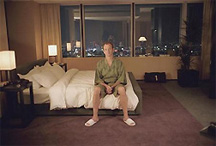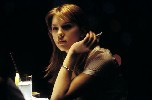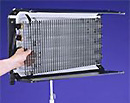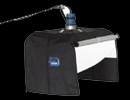Softer, Lower Intensity
In a nutshell, there has been a shift
towards softer, lower intensity lighting. The illumination is achieved primarily
with Kino Flos, Chinese lanterns, and most recently, LED panels. All of the
principles previously discussed still apply (i.e., three point lighting,
exposure ratios, etc.).


Chinese Lantern & Kino Flo
This approach is used in both film and DV, small and big budgets.
Cinematographer Lance Acord often uses it in his work, including the acclaimed
Lost in
Translation. In the shot below the lanterns
are right in the frame (the bedside lamps).

Lost in
Translation
High vs. Low Key
In the past, soft lighting was typically used
for high key setups. The current breed of
cinematographers use soft lighting for both high and low key setups.
In fact, a number of scenes in
Lost in
Translation are low key:

Low Key Using Soft Lighting
The trick to avoiding the flat look
usually associated with soft light is to use
side lighting. This
results in shadow areas which serve to model the subject. Of
course, the precise angle of the light depends on the look you
are trying to achieve.
Setup
To create side lighting, the Kinos and Chinese
lanterns are placed at strategic points around the perimeter
of the set, usually at eye level.
On locations where you want to preserve
the natural light, the existing light sources are used as a guide for
placement. The Kinos and Chinese lanterns will then serve to enhance the
natural light. This approach is often used for documentaries and productions
with tight schedules.
Whether you use Kinos or Chinese Lanterns
(or both) is a matter of personal choice. The quality of the light is
similar, but the fixtures are radically different. Some cinematographers favor Kinos, while others favor the
simplicity of the Chinese lanterns.
Fill Light
From
previous lessons you know that
fill light is important in creating the key
level (mood) of the shot by increasing or decreasing shadows. This principle still holds true here, but with an
interesting twist as to how the fill is achieved.
Kinos and Chinese
lanterns are low intensity lights. They are so low,
in fact, that ambient light on the set is usually enough to act as fill.
In other words, in most cases, you will not need a dedicated fill light.
If the ambient fill light is not adequate,
you can:
Exposure Metering
The
principles of exposure and contrast previously discussed still apply, too. The
catch is that using an exposure meter at such low light
levels becomes increasingly difficult.
Film stocks are becoming faster and DV
cameras are approaching the sensitivity of the human eye. It makes sense,
then, that your eyes are your best tool in judging exposure and contrast.
Consequently, when light levels are too
low for the proper use of a meter, the best approach is to make the lighting
look as natural as possible to your eye. Do the final tweaking by checking the
shot against a video monitor, particularly highlights and shadows.
Lighting Control
Lite Panels, Kino Flo Lighting, and other brands have their
own accessories for lighting control, including louvers and dimmers. Louvers
are used to control directionality and spillage:

Kino Flo Louver
Chinese lanterns are a bit tricky because
you must improvise. A black skirt made of Duvetyn can be used to direct the
light and control spill. Professional Chinese lanterns like those made by
Chimera
Lighting have
their own accessories for lighting control:

Chimera Lantern